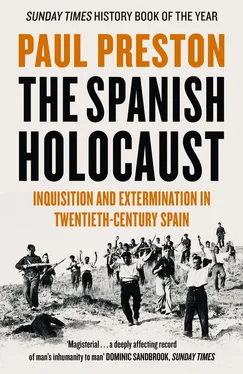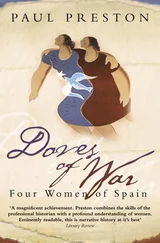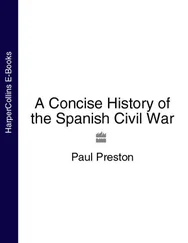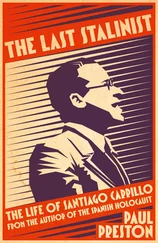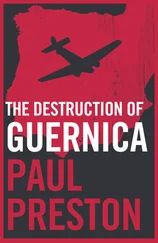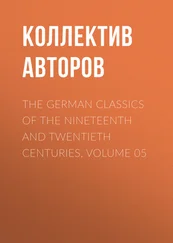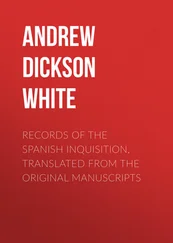Among the first of them was one of the most brilliant officers in the Spanish forces, Captain Virgilio Leret Ruiz, a thirty-four-year-old pilot and an aeronautical engineer of genius, the commander of the Atalayón seaplane base at Melilla. He had opposed the rebels, been detained and shot after a summary trial. His wife Carlota O’Neill, a left-wing feminist, dramatist and journalist, was arrested and separated from her daughters Carlota and Mariela. Many other wives and daughters of Republicans were seized, raped and tortured by Falangists. This was central to the reign of terror initiated by Luis Solans. In late September, a gang of Falangists came to the prison with the intention of killing all the female detainees to celebrate the rebel capture of Toledo. The director of the prison reprimanded them, saying, ‘it’s outrageous to kill them all at once. When you want to kill women, by all means come and get them, but one at a time.’ They left with several victims who were never seen again. After eighteen months in prison, Carlota O’Neill was court-martialled, accused of speaking Russian, of subversion and of responsibility for her husband’s actions on 17 July 1937. Nevertheless, she was sentenced to ‘only’ six years. 11
Having secured their Moroccan base, the rebels’ next objective was Cádiz, the crucial port where the African Army would disembark. At 1.00 a.m. on 18 July, the military commander of Cádiz, Brigadier General José López-Pinto, assured the Civil Governor, Mariano Zapico, of his loyalty to the Republic. Three hours later, he declared for the rebels, imposed martial law and ordered the release of Brigadier General José Enrique Varela Iglesias. Arrested by the Republican authorities on 17 July rightly suspected of military conspiracy, Varela would play a central role in the rebel cause. The civilian plotters in Cádiz were led by a prominent landowner, José de Mora-Figueroa, the Marqués de Tamarón. Mora-Figueroa was head of the Falange in Cádiz; his brother Manuel, a naval officer, led its militia. In liaison with one of the key plotters in Seville, Ramón de Carranza, a retired naval captain, who was also Marqués de Soto Hermoso, the Mora-Figueroa brothers had been busy purchasing and stockpiling weapons.
Now, López Pinto and Varela were quickly joined by Mora-Figueroa’s Falangists. The Republican authorities took refuge in the town hall and the offices of the Civil Governor. They were defended by several hundred sparsely armed civilian Republicans and about fifty Assault Guards. López Pinto and Varela had about three hundred soldiers, fifty-odd Falangists and Carlist Requetés and a dozen Civil Guards. The buildings were subjected to artillery bombardment but held out until the arrival from Ceuta, late on the night of 18 July, of the destroyer Churruca and a merchant steamer carrying a unit of Regulares. 12Thereafter, the coup was certain of success in the city.
One after another the following morning, the town hall, the Civil Governor’s offices, the telephone exchange, the main post office and the headquarters of left-wing parties and trades unions surrendered virtually without resistance. All those within were detained and numerous members of the town council murdered without even a semblance of a trial. The Mayor, Manuel de la Pinta Leal, was not in Cádiz at the time of the coup and thus in no position to oppose it. Nevertheless, he was arrested in Córdoba in September, taken to Cádiz and shot. Over the days following the capture of Cádiz, the Civil Governor, the President of the provincial assembly (Diputación) and numerous officers who had refused to join the rebellion were accused of military rebellion. While detained, they wrote statements pointing out the absurdity of the accusations, since they were obeying the orders of the legal government and had merely defended themselves. Before any trials could take place, they and several others, including a Socialist parliamentary deputy and the town-hall lawyer, were simply taken from prison and murdered on or about 16 August, on the orders of General Gonzalo Queipo de Llano, rebel commander of the south. 13
The annihilation of less prominent leftists took place as follows. The rebels first closed off the narrow tongue of land that connected Cádiz to the rest of Spain. Groups of Falangists, Civil Guards and Regulares then searched and looted houses. Liberals and leftists, Freemasons and trade unionists, were arrested en masse. Some were shot directly in the street. Others were taken to Falange headquarters in the Casino where they were subjected to sadistic torture. They were forced to ingest a litre of castor oil and industrial alcohol mixed with sawdust and breadcrumbs. In acute abdominal pain, they were savagely beaten. A so-called ‘Tribunal of Blood’ was established and each day would select twenty-five of the detainees for execution. Over six hundred of those arrested in Cádiz were executed in the next five months and more than one thousand in the course of the war. A further three hundred would be executed between the end of the war and 1945. These figures do not include those who died in prison as a result of torture. 14
The conquest of the remainder of the province was carried out with the enthusiastic collaboration of the local landowning class, many of whose younger elements had already joined the Falange or the Requeté. In Alcalá de los Gazules, to the east of Cádiz, local Falangists and Civil Guards took control of the town immediately, murdering the Mayor and town councillors, along with fifty others. In the surrounding villages, Popular Front Committees had been formed. They had detained those rightists known to support the coup and began to distribute grain and cattle among the families of landless labourers. The local landlords responded immediately by providing horses for a mounted squad to recover their property. Moving south-west, through Roche and Campano between Chiclana and Conil, the squad recaptured numerous estates that had been occupied by peasant families. Men, women and children were seized and taken back to Alcalá de los Gazules, many to be killed. 15
After the fall of Cádiz, José Mora-Figueroa took his men to Jérez de la Frontera where the rising had triumphed immediately thanks to the decisive action of the military commander, another scion of a local landowning family, Major Salvador de Arizón Mejía, the Marqués de Casa Arizón, director of the army’s horse-breeding and training establishment. He and his brother, Captain Juan de Arizón Mejía, used the horses from their unit to ride out in columns to take control of the surrounding areas. 16Mora-Figueroa also organized mounted groups with friends and their employees, which he put at the disposal of the military authorities in Cádiz. 17The aim was not just to crush opposition to the rising but also to reverse the agrarian conquests of the previous years.
Most of the other principal towns of the province fell quickly. On 19 July, Salvador Arizón Mejía sent troops from Jérez to seize the port of Sanlúcar de Barrameda in the north. Supporters of the Popular Front held them off until, on 21 July, a force of Regulares entered the town, killing twelve citizens including nine in one house. Executions began immediately, although a few leftists escaped in small boats. Eighty people were shot over the next five months. 18In Rota, nothing happened on 18 July. The following day, having been deceived into believing that the Civil Guard and Carabineros were loyal, the town’s anarchists, Socialists and Communists joined in declaring a general strike and establishing an anti-fascist committee. Falangists and other rightists were detained and roads into the town barricaded. When the Civil Guard declared in favour of the rebels, the anti-fascist committee surrendered without a fight. Despite the absence of left-wing violence, the Falange and the Civil Guard set about the systematic annihilation of the town’s relatively few liberals and leftists. They were tortured and forced to drink castor oil, and over sixty were shot at night, their ears cut off as trophies. 19
Читать дальше
